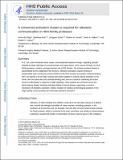| dc.contributor.author | de Regt, Anna K. | |
| dc.contributor.author | Kim, Seokhee | |
| dc.contributor.author | Sohn, Jungsan | |
| dc.contributor.author | Grant, Robert A. | |
| dc.contributor.author | Baker, Tania A. | |
| dc.date.accessioned | 2017-01-11T17:08:46Z | |
| dc.date.available | 2017-01-11T17:08:46Z | |
| dc.date.issued | 2015-02 | |
| dc.date.submitted | 2015-01 | |
| dc.identifier.issn | 0969-2126 | |
| dc.identifier.issn | 1878-4186 | |
| dc.identifier.uri | http://hdl.handle.net/1721.1/106341 | |
| dc.description.abstract | In E. coli, outer-membrane stress causes a transcriptional response through a signaling cascade initiated by DegS cleavage of a transmembrane anti-sigma factor. Each subunit of DegS, an HtrAfamily protease, contains a protease domain and a PDZ domain. The trimeric protease domain is
autoinhibited by the unliganded PDZ domains. Allosteric activation requires binding of unassembled outer-membrane proteins (OMPs) to the PDZ domains and protein-substrate binding. Here, we identify a set of DegS residues that cluster together at subunit-subunit interfaces in the
trimer, link the active sites and substrate-binding sites, and are crucial for stabilizing the active enzyme conformation in response to OMP signaling. These residues are conserved across the HtrA-protease family, including orthologs linked to human disease, supporting a common
mechanism of allosteric activation. Indeed, mutation of residues at homologous positions in the DegP quality-control protease also eliminates allosteric activation. | en_US |
| dc.description.sponsorship | National Institutes of Health (U.S.) (Grant AI-16892) | en_US |
| dc.description.sponsorship | Charles A. King Trust (Postdoctoral Fellowship) | en_US |
| dc.language.iso | en_US | |
| dc.publisher | Elsevier | en_US |
| dc.relation.isversionof | http://dx.doi.org/10.1016/j.str.2015.01.012 | en_US |
| dc.rights | Creative Commons Attribution-NonCommercial-NoDerivs License | en_US |
| dc.rights.uri | http://creativecommons.org/licenses/by-nc-nd/4.0/ | en_US |
| dc.source | PMC | en_US |
| dc.title | A Conserved Activation Cluster Is Required for Allosteric Communication in HtrA-Family Proteases | en_US |
| dc.type | Article | en_US |
| dc.identifier.citation | de Regt, Anna K. et al. “A Conserved Activation Cluster Is Required for Allosteric Communication in HtrA-Family Proteases.” Structure 23.3 (2015): 517–526. | en_US |
| dc.contributor.department | Massachusetts Institute of Technology. Department of Biology | en_US |
| dc.relation.journal | Structure | en_US |
| dc.eprint.version | Author's final manuscript | en_US |
| dc.type.uri | http://purl.org/eprint/type/JournalArticle | en_US |
| eprint.status | http://purl.org/eprint/status/PeerReviewed | en_US |
| dspace.orderedauthors | de Regt, Anna K.; Kim, Seokhee; Sohn, Jungsan; Grant, Robert A.; Baker, Tania A.; Sauer, Robert T. | en_US |
| dspace.embargo.terms | N | en_US |
| mit.license | PUBLISHER_CC | en_US |
